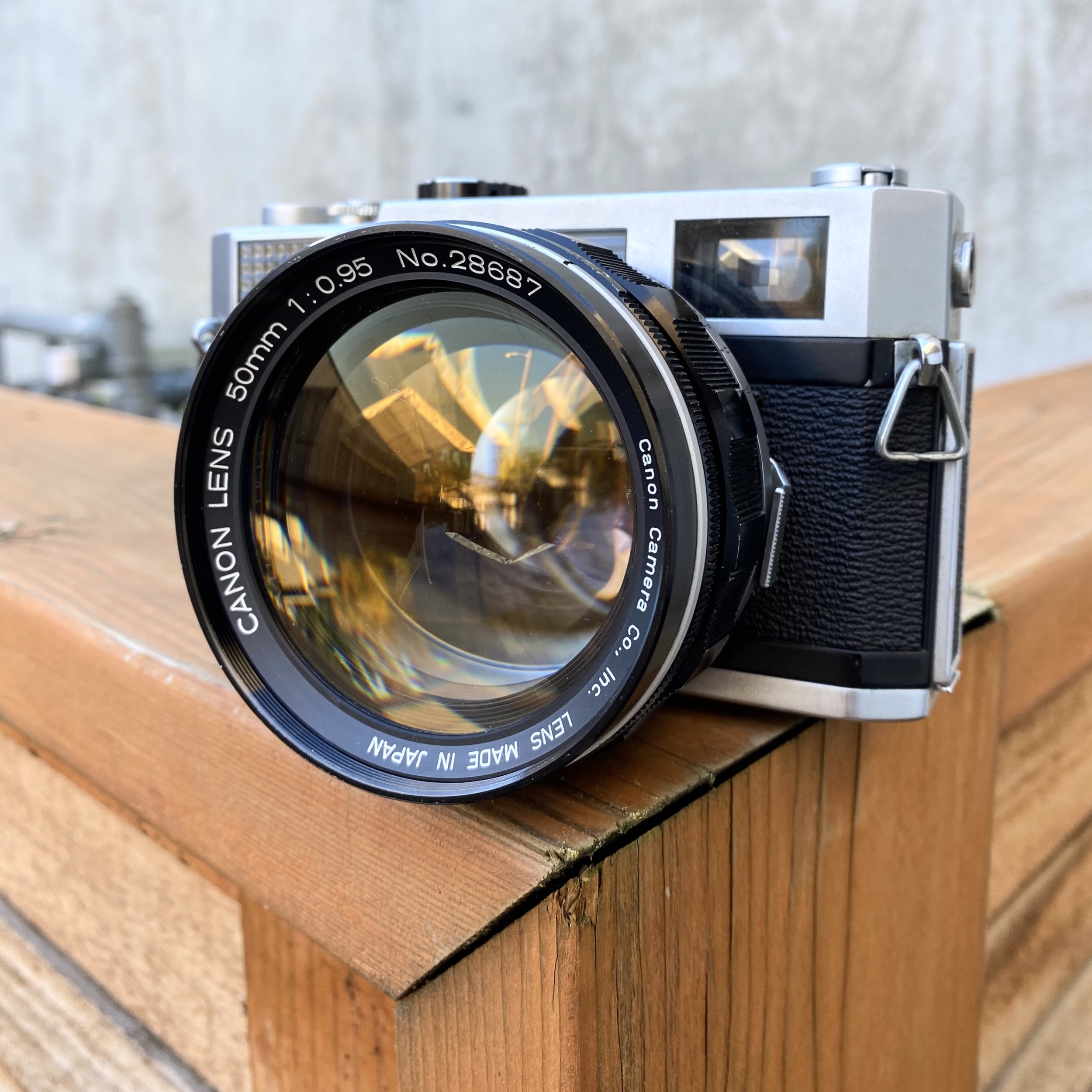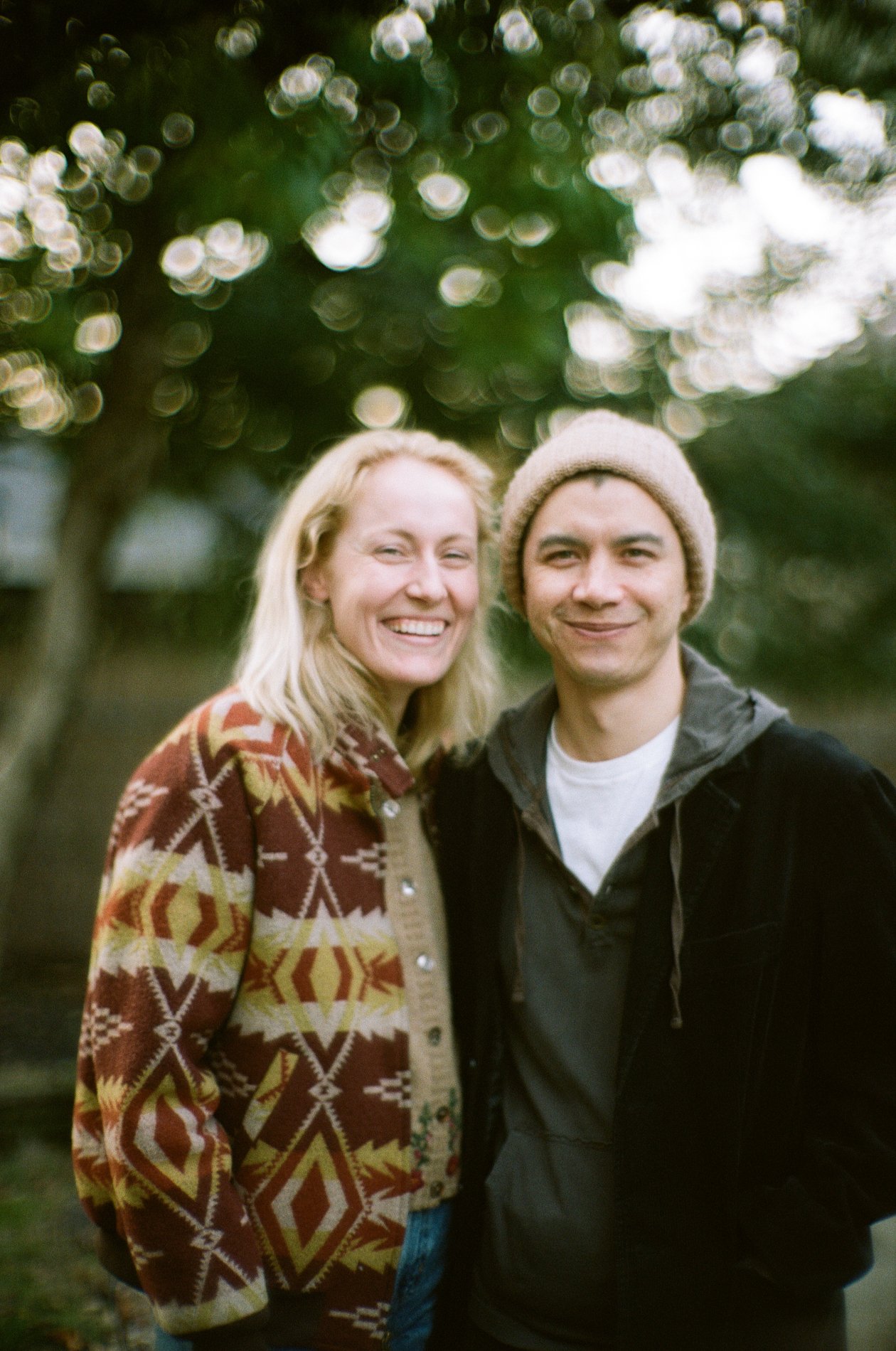Living with the Canon 50mm f0.95 "Dream Lens"
My friend and I sat at his grandmother’s table, loading our cameras for the day. We were 15, fresh in the excitement of film, all possibility. Noticing the film we loaded, his grandmother said, “Oh Sam, I think I still have your grandfather’s old camera — let me go see if I can find it.” Moments later she returned and set down a brown leather bag stamped “Leica” in front of us. Inside, we found something even more special — a Canon 7 camera with a 50mm f0.95 “Dream Lens” mounted to it. My eyes went wide as I tried to contain my jealousy at this find. Sam asked, “Whoa, what is this?”
The Canon 50mm f0.95 “Dream Lens” has captured the imagination of many photographers since its introduction in in August of 1961. The 1950s and 60s were the heyday of rangefinder cameras, with companies like Canon and Nikon competing to outdo Leica in camera and lens design. One area of heated competition was the production of ultra-high-speed optics for use in low light. This arms race began in 1953 with the introduction of the Zunow 50mm f1.1 lens for Nikon S-Mount and later culminated in the Leica 50mm f1.2 and 50mm f1 Noctilux lenses. But not even the legendary Noctilux can match the presence and mystique of the Canon 50mm f0.95.
Formulated by famed lens designer Mukai Jirou (who also designed the Canon 35mm f1.5 and Canon 35mm f1.8 LTM lenses), the Canon 50mm f0.95 is constructed of 7 lens elements in 5 groups. It is a gauss-type design and features a 10-blade aperture stopping down to f/16. The lens weighs a substantial 605 grams and accepts 72mm filters. One interesting note about the Canon 50mm f0.95 is that, unlike its LTM siblings, it has a proprietary lens mount specifically designed for the Canon 7 camera. The rear lens group fits inside the standard LTM mount of the Canon 7, but the lens is locked to the camera body using an external bayonet similar to the Nikon S rangefinder mount. A set of winged silver tabs allows the 50mm f0.95 to lock securely to this outer mount. The rear element is so large that the glass is shaved down on one side to make room for the rangefinder cam.
The Canon 50mm f0.95 is a front-heavy optic, but the chunky solidity of the Canon 7 camera body helps to stabilize the lens. While the Canon 7 cannot match the svelte beauty of a Leica rangefinder, it is a durable camera with a solid feature set and intuitive, ergonomic controls. Many Canon 7 cameras, such as the body used for this test, are still working today without being serviced. This is a testament to the build quality of the camera, and to the choice of materials used — the metal shutter curtain in the Canon 7 is far more durable than the cloth curtains found in most rangefinders.
The viewfinder of the Canon 7 has a 0.8x magnification and features user-selectable projected bright lines for composition. As we can see in this view through the finder, the large diameter of the Canon 50mm f0.95 includes into the viewfinder frame substantially. The rangefinder patch, while not as bright or crisply defined as in a Leica, gets the job done.
Years passed after my friend’s Dream Lens inheritance, but the sight of that deep pool of glass stayed lodged in my mind. On a recent trip to visit him in Denver, I proposed a swap: I would continue to lend him my Minolta CLE kit (truly his now through the memories he has made with it) and bring him a Fuji GSW690II to play with — if he would loan me his Dream Lens. After a long weekend of exploring Denver and Boulder together, I returned to Portland with the Canon 7 and 50mm f0.95 wrapped tightly in my bag like a precious stone.
Canon 50mm f0.95 @ f0.95 / Canon 7/ Kodak Portra 400 - Gabriel Binder
Finally I had the chance to explore the character of the Canon 50mm f0.95 at my own pace. In the past decade working at camera stores I had seen three or four copies of the Dream Lens, usually converted to Leica M mount, which were invariably snapped up by eager customers before I had the chance to test them. Canon only produced around 20,000 50mm f0.95 lenses (with an additional 7,000 mounted for cinema use) making them quite rare to find in good condition today. At its introduction in 1961 the Dream Lens cost 57,000 yen, or over $4000 dollars in today’s money — the 50mm f0.95 has always been a lens for the wealthy and well-connected. With the film community’s interest in vintage lenses and bokeh quality at at all-time high, I was eager to discover how the Dream Lens stacked up against its lofty reputation.
Canon 50mm f0.95 @ f0.95 / Canon 7/ Kodak Portra 400 - Gabriel Binder
Our shutter testing machine showed that the dented metal curtain in my friend’s Canon 7 was firing with remarkable accuracy, so I loaded the camera with Kodak Portra 400 and ensured the breech lock of the 50mm f0.95 was securely tightened. Focusing for the first time, you notice how long the focus travel is (nearly 180 degrees) and the firm dampening of the ring. The long travel allows for precision focus critical to focusing the lens at f0.95, but combined with the somewhat dim rangefinder patch, it does slow focusing to a methodical pace.
Focused accurately at f0.95, the Dream Lens creates a thin sliver of definition against a background thrown deeply out of focus. Even when focused correctly, the flare produced at maximum aperture creates a soft-focus effect that contributes to the lens’ ethereal quality. Focus and exposure bracketing are crucial when using the 50mm f0.95, as it is easy to over-expose at f0.95 even at 1/1000 in dim light.
Canon 50mm f0.95 @ f0.95 / Canon 7/ Kodak Portra 400 - Gabriel Binder
Bokeh is busy, with “cat’s eye” highlight shapes and lots of “bubble” outlining visible when shooting against foliage. This gives the Canon 50mm f0.95 a dramatic background swirl for portraiture. Non-highlight bokeh is much more subtle, with smooth transitions in and out of focus. This plasticity is especially pleasing when focusing on small details in a close-up scene, creating a fluid pull to the focal point.
I had expected the Dream Lens to be an excellent tool for portraiture, and I was not disappointed — though I did come to learn that patient portrait subjects are key when trying to nail focus at f0.95. What I did not anticipate is how the f0.95 aperture allows you to explore small details of everyday scenes with a new perspective. At f0.95, a sidewalk flower is the focus of its own silky universe, an effect simply not possible with an f2.8 lens. I am a big fan of “character” lenses and shoot frequently with some of the greats: the Leica 35mm f1.4 Summilux Pre-Asph, Canon 50mm f1.2 LTM, and Olympus OM 50mm f1.2 are regular personalities in my kit. Each of these lenses are sought after for their unique character shot wide open, but none of them can create the same dramatic separation of the subject. The Canon 50mm f09.5 lives up to its “Dream” moniker — no other lens I have tested can match the impressionistic quality of its rendering.
Canon 50mm f0.95 @ f0.95 / Canon 7/ Kodak Portra 400 - Gabriel Binder
The Dream Lens is designed to be shot wide open, and it can feel like a waste of the lens’ potential to stop the aperture down. 50mm lenses that cost 20 times less than the 50mm f0.95 can achieve the same performance at f8. Still, the Canon 50mm f0.95 is a capable performer stopped down. Sharpness and contrast increase significantly by f2.8, giving the lens a more “normal” rendering. It is remarkable how much easier it is to achieve accurate focus at f2.8 than f0.95.
Left: Canon 50mm f0.95 @ f0.95 — Right: Canon 50mm f0.95 @ f2.8
The Canon 50mm f0.95 makes an impression on everyone who sees it. Non-photographers eye the expanse of glass with cautious curiosity, noticing that something is not quite right. Even at Blue Moon, where we are blessed to see all manner of rare and interesting film equipment, the Dream Lens stopped my coworkers in their tracks. “Is that what I think it is?” my coworker John asked in a low voice as I set the lens on the counter. It is precisely this presence that makes the 50mm f0.95 so special. The Dream Lens represents the excitement at the edge of human engineering and imagination, even more than 60 years after it was created.
Canon 50mm f0.95 @ f0.95 / Canon 7/ Kodak Portra 400 - Gabriel Binder
Recently I carried the Canon 7 and 50mm f0.95 at our Blue Moon Customer Show in which we print and display the fine work of our customers at different venues around St. Johns. As we toasted the prints and walked between venues I was stopped by friends and strangers alike, some asking, “What is that,” and others simply nodding in approval. More than its insane light-gathering ability or painterly soft-focus rendering, the Dream Lens’ most unique characteristic is the way excites and inspires all manner of different folks in the film community. The Canon 50mm f0.95 is a touchstone in photographic history and in the collective psyche of film photographers, and you can feel a part of that energy just by holding it. When it is time to send the Dream Lens back to my friend, I will be sad to see it go, but I will also be excited to return it to him having shared in its magic and added my own visions to its history.
Gabriel Lee Binder
Jan 27, 2023
All images: Canon 50mm f0.95 @ f0.95 / Canon 7 / Portra 400 - Gabriel Binder






















